|
Africa Trip -
September 2010
South Africa - Botswana - Zambia
|
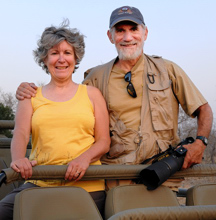 |
|
Africa Trip -
September 2010
South Africa - Botswana - Zambia
|
 |
Botswana - Xakanaxa Camp (9/10-13/2010)
|
Back to trip index |
| After two
days of exploring the delta by boat from Camp Okavango, it was good to
get back to dry land and our mobile safari vehicles. From Xakanaxa
Lagoon, we spent the rest of the afternoon on a game drive through the
Mopane forests to our new camp at Xakanaxa. As we headed out to our
camp at Xahanaxa, we ran into a small group of elephants eating Mopane
leaves. One member of the group was a young female that we noticed had
lost her tail and about half of here trunk. This sort of damage was
something we saw alot of in the animals in the bush. It is a tough life
in the wild and surviving can be physically costly. On a lighter tone,
we ran into a troop of baboons and spent about an hour
watching the members interact. It is very easy to watch the antics of
the youngsters in the troop and the interaction of mother and babies as
they forage. Filling up memory cards with baboon images is very easy to
do. The Xakanaxa area is deeper into the delta than
Xini Camp and there was much more
water especially covering many of the roads. The real advantage of the
safari vehicles equipped with snorkels quickly became evident on our
game drive. It became necessary for the guides to scout out many of the
deeper water crossings on foot before taking the vehicles through. As
sundown approached we got a call that one of the vehicles was stuck and
we all had to search around to find it and tow it out of the mud.
There were a couple of muddy faces at our sundowner near the mud hole.
When we finally arrived at camp, we found our tents set up and after a
bucket shower, we had a great meal with the group in the mess tent.
The next day we returned to our early morning and late afternoon game drive schedule. On the morning drive we came upon a pride of lions that we observed for an hour. The patriarch of the pride was a large male that gave us some great poses. Later in the morning we went to explore the carcass of a female elephant that one of the guides had spotted the week before our safari started. What we found was skeleton of the animal spread out over a large area. We even found the skull complete with two good sized tusks. According to our guides the old female died of natural causes, not poaching, which was borne out by the presence of the ivory. The skeleton was very interesting and we got to play big game hunter with the tusks. The weight of the ivory was impressive and the guides estimated each tusk was worth about $10,000. The guides took the tusks to park headquarters to turn them in. Our camp at Xakanaxa was close to a large pond and every evening we were treated to a background serenade of reed frogs tinkling with occasional grunting of hippos. After two melodious nights at Xakanxa we broke camp and after a morning game drive in the area east of the camp, we continued on the road east. We finally left the Moremi reserve and drove about 50 km over bush roads to the Khwai area where our next camp was located. Each vehicle was separated by a couple of kilometers so we didn't have to eat the dust of the vehicles in front. While cruising down the road our guide suddenly slammed on the brakes and jumped out of the vehicle. It turned out he thought he had hit a snake on the road, but it turned out he had just spooked it into the bush on the side of the road. After poking around, he called us out of the vehicle to see a Mole snake that was in the process of swallowing a lizard he had caught. we spent the next 10 minutes watching this three foot snake slowly engulf a rather large lizard. We finally arrived in the Khwai area about an hour later and started to explore the area.
|
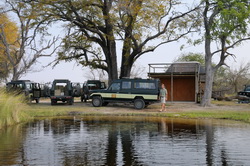 Back to our vehicles 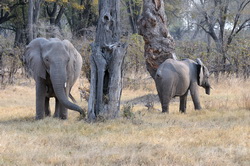 Young disfigured elephant 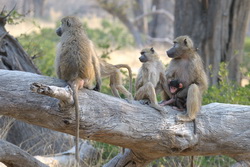 Baboon troop 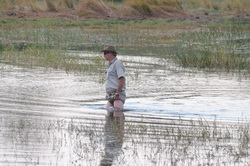 Scouting water crossing 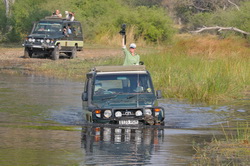 Water crossing 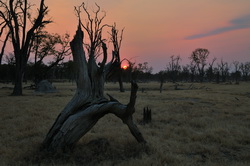 Sunset at camp 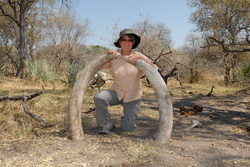 Elephant hunter  Mole snake meal |
| Slideshow |
|
|
|
|
|
|
|
|
|